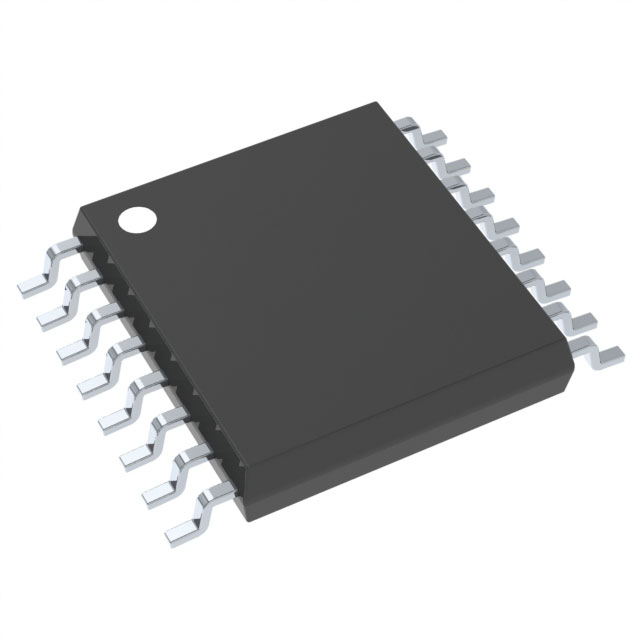Zie specificaties voor productdetails.

CD74HC85PWR
Product Overview
- Category: Integrated Circuit (IC)
- Use: Binary Comparator
- Characteristics: High-Speed, CMOS Logic, 4-Bit Magnitude Comparator
- Package: TSSOP (Thin Shrink Small Outline Package)
- Essence: The CD74HC85PWR is a 4-bit magnitude comparator IC that compares two 4-bit binary numbers and determines their relative magnitudes.
- Packaging/Quantity: Available in reels of 2500 pieces.
Specifications
- Supply Voltage: 2V to 6V
- Logic Family: HC
- Number of Bits: 4
- Propagation Delay: 11 ns (typical)
- Operating Temperature Range: -40°C to +85°C
- Input Current: ±1µA (maximum)
- Output Current: ±25mA (maximum)
Detailed Pin Configuration
The CD74HC85PWR has a total of 16 pins. Here is the detailed pin configuration:
- A0: Input A, Bit 0
- A1: Input A, Bit 1
- A2: Input A, Bit 2
- A3: Input A, Bit 3
- B0: Input B, Bit 0
- B1: Input B, Bit 1
- B2: Input B, Bit 2
- B3: Input B, Bit 3
- GND: Ground
- LT: Less Than Output
- EQ: Equal Output
- GT: Greater Than Output
- VCC: Supply Voltage
- NC: No Connection
- NC: No Connection
- NC: No Connection
Functional Features
The CD74HC85PWR offers the following functional features:
- High-speed operation, making it suitable for time-critical applications.
- CMOS logic technology ensures low power consumption and compatibility with a wide range of devices.
- 4-bit magnitude comparison capability allows for comparing two 4-bit binary numbers efficiently.
- Outputs indicate whether the first number is less than, equal to, or greater than the second number.
Advantages and Disadvantages
Advantages of CD74HC85PWR:
- Fast operation speed enables quick comparison of binary numbers.
- Low power consumption due to CMOS technology.
- Compact TSSOP package saves board space.
- Wide supply voltage range allows for flexibility in various applications.
Disadvantages of CD74HC85PWR:
- Limited to 4-bit magnitude comparison, not suitable for larger bit sizes.
- May require additional external components for specific applications.
Working Principles
The CD74HC85PWR works based on the comparison of individual bits of two 4-bit binary numbers. It compares corresponding bits from both inputs (A and B) and determines their relative magnitudes. The outputs LT, EQ, and GT indicate whether the first number is less than, equal to, or greater than the second number, respectively.
Detailed Application Field Plans
The CD74HC85PWR can be used in various applications that involve binary number comparison. Some potential application fields include:
- Digital signal processing systems
- Arithmetic logic units (ALUs)
- Microcontrollers and microprocessors
- Data encryption and decryption circuits
- Communication systems
- Industrial automation
Detailed and Complete Alternative Models
Here are some alternative models that offer similar functionality to CD74HC85PWR:
- SN74HC85: Similar 4-bit magnitude comparator IC from Texas Instruments.
- MC14585: 4-bit magnitude comparator IC from ON Semiconductor.
- CD74HCT85: 4-bit magnitude comparator IC with TTL logic compatibility from Texas Instruments.
These alternative models can be considered based on specific requirements and availability in the market.
Word count: 442 words
Noem 10 veelgestelde vragen en antwoorden met betrekking tot de toepassing van CD74HC85PWR in technische oplossingen
Sure! Here are 10 common questions and answers related to the application of CD74HC85PWR in technical solutions:
1. What is CD74HC85PWR? - CD74HC85PWR is a high-speed CMOS 4-bit magnitude comparator integrated circuit (IC) that can be used in various digital applications.
2. What is the purpose of CD74HC85PWR? - The purpose of CD74HC85PWR is to compare two 4-bit binary numbers and determine their relationship (greater than, less than, or equal).
3. What voltage levels does CD74HC85PWR support? - CD74HC85PWR supports voltage levels ranging from 2V to 6V, making it compatible with both TTL and CMOS logic families.
4. How many inputs and outputs does CD74HC85PWR have? - CD74HC85PWR has eight inputs (four for each 4-bit number) and three outputs (A > B, A < B, and A = B).
5. Can CD74HC85PWR handle asynchronous inputs? - No, CD74HC85PWR requires synchronous inputs, meaning that both 4-bit numbers being compared must be stable during the comparison process.
6. What is the maximum operating frequency of CD74HC85PWR? - CD74HC85PWR can operate at frequencies up to 50 MHz, making it suitable for high-speed digital systems.
7. Can CD74HC85PWR be cascaded to compare larger numbers? - Yes, multiple CD74HC85PWR ICs can be cascaded together to compare larger numbers by connecting the carry output of one IC to the carry input of the next.
8. Does CD74HC85PWR have any built-in latching or memory functions? - No, CD74HC85PWR is a combinational logic IC and does not have any built-in latching or memory functions.
9. What are the typical applications of CD74HC85PWR? - CD74HC85PWR can be used in various applications such as arithmetic operations, data sorting, priority encoders, and control circuitry.
10. Is CD74HC85PWR readily available and easy to use? - Yes, CD74HC85PWR is a commonly available IC and is relatively easy to use with proper understanding of its pin configuration and operating characteristics.
Please note that these questions and answers are for informational purposes only and may vary depending on specific technical requirements and application scenarios.

